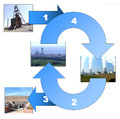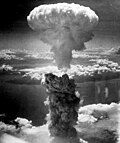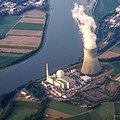The Nuclear Technology Portal
Introduction

- Nuclear technology is technology that involves the nuclear reactions of atomic nuclei. Among the notable nuclear technologies are nuclear reactors, nuclear medicine and nuclear weapons. It is also used, among other things, in smoke detectors and gun sights. (Full article...)
- Nuclear power is the use of nuclear reactions to produce electricity. Nuclear power can be obtained from nuclear fission, nuclear decay and nuclear fusion reactions. Presently, the vast majority of electricity from nuclear power is produced by nuclear fission of uranium and plutonium in nuclear power plants. Nuclear decay processes are used in niche applications such as radioisotope thermoelectric generators in some space probes such as Voyager 2. Reactors producing controlled fusion power have been operated since 1958 but have yet to generate net power and are not expected to be commercially available in the near future. (Full article...)
- A nuclear weapon is an explosive device that derives its destructive force from nuclear reactions, either nuclear fission (fission or atomic bomb) or a combination of fission and nuclear fusion reactions (thermonuclear weapon), producing a nuclear explosion. Both bomb types release large quantities of energy from relatively small amounts of matter. (Full article...)
General images -
Selected article -
HER was a civil project, not a military one. Staff were drawn from and recruited into the Civil Service, and were paid Civil Service salaries. It was headed by Lord Portal, as Controller of Production, Atomic Energy, in the Ministry of Supply. An Atomic Energy Research Establishment was located at a former airfield, Harwell, in Berkshire, under the direction of John Cockcroft. The first nuclear reactor in the UK, a small research reactor known as GLEEP, went critical at Harwell on 15 August 1947. British staff at the Montreal Laboratory designed a larger reactor, known as BEPO, which went critical on 5 July 1948. They provided experience and expertise that would later be employed on the larger, production reactors.
Production facilities were constructed under the direction of Christopher Hinton, who established his headquarters in a former Royal Ordnance Factory at Risley in Lancashire. These included a uranium metal plant at Springfields, nuclear reactors and a plutonium processing plant at Windscale, and a gaseous diffusion uranium enrichment facility at Capenhurst, near Chester. The two Windscale reactors became operational in October 1950 and June 1951. The gaseous diffusion plant at Capenhurst began producing highly enriched uranium in 1954.
William Penney directed bomb design from Fort Halstead. In 1951 his design group moved to a new site at Aldermaston in Berkshire. The first British atomic bomb was successfully tested in Operation Hurricane, during which it was detonated on board the frigate HMS Plym anchored off the Monte Bello Islands in Australia on 3 October 1952. Britain thereby became the third country to test nuclear weapons, after the United States and the Soviet Union. The project concluded with the delivery of the first of its Blue Danube atomic bombs to Bomber Command in November 1953, but British hopes of a renewed nuclear Special Relationship with the United States were frustrated. The technology had been superseded by the American development of the hydrogen bomb, which was first tested in November 1952, only one month after Operation Hurricane. Britain went on to develop its own hydrogen bombs, which it first tested in 1957. A year later, the United States and Britain resumed nuclear weapons cooperation. (Full article...)
Selected picture -
Attribution: The Ames Laboratory, USDOE (http://www.ameslab.gov/)
Did you know?
- ... that the medieval Castle Knob was the site of a Cold War nuclear monitoring station?
- ... that an official investigation found the Fukushima nuclear accident was foreseeable and preventable?
- ... that the 1991 Andover tornado narrowly avoided hitting two warplanes equipped with nuclear warheads?
- ... that after a 2008 tornado, Michael Chertoff likened Picher, Oklahoma, to a nuclear bomb site?
- ... that the Russian and Belarussian military exercise Zapad 2009 involved nuclear-capable ballistic missiles?
- ... that the role of the British Mobile Defence Corps was to carry out rescue work in the aftermath of a nuclear attack?
Related WikiProjects
Things you can do
| Parts of this portal (those related to section) need to be updated. Please help update this portal to reflect recent events or newly available information. Relevant discussion may be found on the talk page. (September 2021) |
|
Here are some Open Tasks :
|
Selected biography -
Nuclear technology news
- 1 August 2025 – Russian invasion of Ukraine
- U.S. president Donald Trump orders the deployment of two United States Navy nuclear submarines near Russia for potential military action against Russian forces in response to statements made by former Russian president Dmitry Medvedev and current deputy chairman of the Security Council of the Russian Federation regarding Trump's previously-stated deadline for ending the war in Ukraine. (Reuters) (BBC News)
Related portals
Related topics
Subcategories
Associated Wikimedia
The following Wikimedia Foundation sister projects provide more on this subject:
-
Commons
Free media repository -
Wikibooks
Free textbooks and manuals -
Wikidata
Free knowledge base -
Wikinews
Free-content news -
Wikiquote
Collection of quotations -
Wikisource
Free-content library -
Wikiversity
Free learning tools -
Wiktionary
Dictionary and thesaurus

























































































